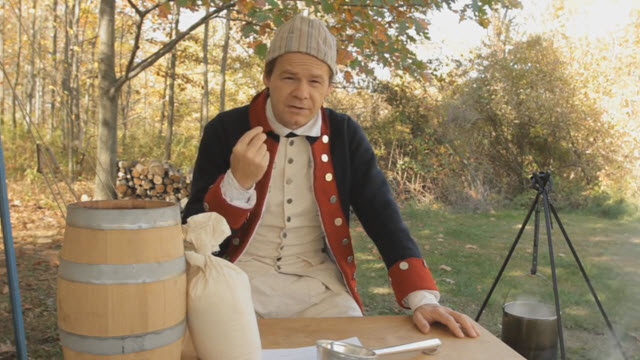
Pork was one of the most common and popular meats in the 18th century. It was one of the meats that would be supplied in rations for soldiers. It was common for sailors and the entire population. Pork was salted so that it would last any number of months and could be transported. Today we’re going to show you a method for salting and preserving your pork in an 18th century manner.
- Pork (We used a shoulder or Picnic cut)
- Salt
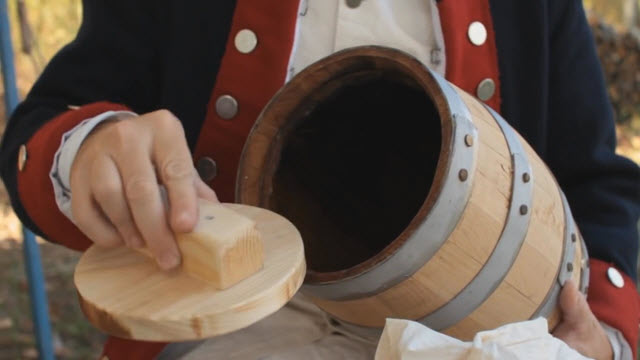 Today we’re going to prepare our salt pork in a 2 gallon oak keg. This one is a well bucket keg that we sell at Jas Townsend & Son’s. This doesn’t have the holes drilled in it. You can ask for a keg like that if you want to do a similar project. This one has been touched up on the inside. We took a torch and melted out the excess wax here at the top, and we also prepared a little wooden lid that will press down on the pork and keep it inside the brine solution.
Today we’re going to prepare our salt pork in a 2 gallon oak keg. This one is a well bucket keg that we sell at Jas Townsend & Son’s. This doesn’t have the holes drilled in it. You can ask for a keg like that if you want to do a similar project. This one has been touched up on the inside. We took a torch and melted out the excess wax here at the top, and we also prepared a little wooden lid that will press down on the pork and keep it inside the brine solution.
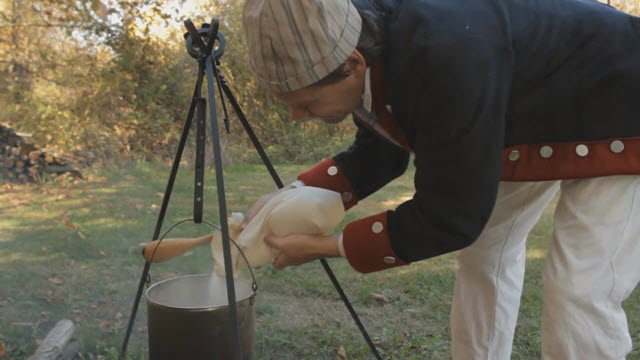 Before we get started packing our meat, we need a hot brine solution prepared. Boil some water and dissolve as much salt in the water as it takes to make a fresh raw egg float in the solution. You will need enough brine water to cover the pork completely.
Before we get started packing our meat, we need a hot brine solution prepared. Boil some water and dissolve as much salt in the water as it takes to make a fresh raw egg float in the solution. You will need enough brine water to cover the pork completely.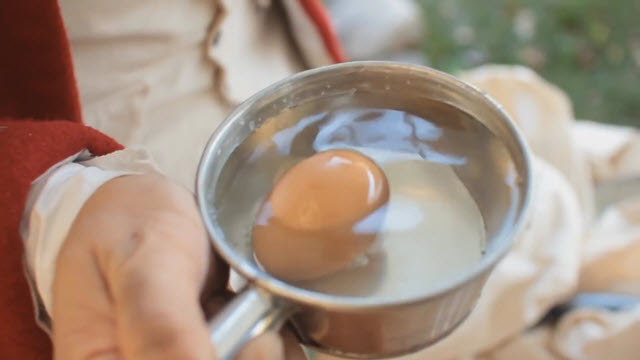
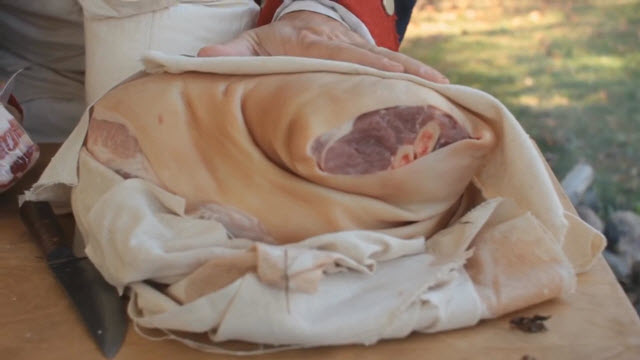
Cut up the pork into 1 pound size pieces so we can layer it so the salt can get into all the pieces. Put about a cup of salt into the barrel so there is a layer of salt in the very bottom.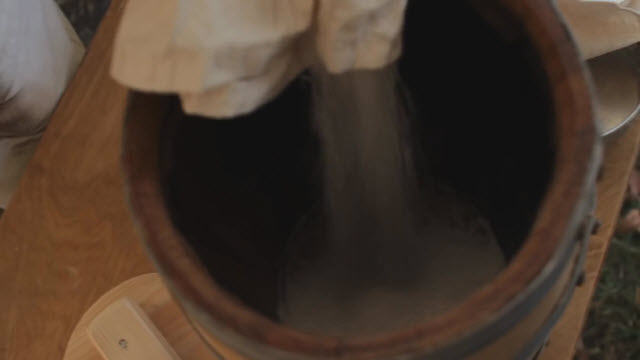 Spread it out and make sure it’s nice and even, then start putting the pork into the barrel.
Spread it out and make sure it’s nice and even, then start putting the pork into the barrel.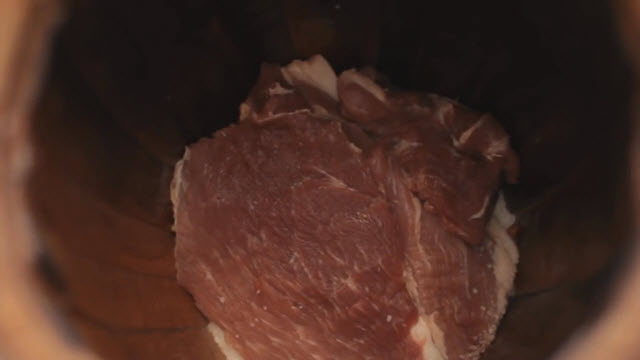
If there are rind pieces on your pork, you want to make sure they are toward the bottom or toward the outside edges with the meat parts on the inside. You want to pack this tight so that there is as small a quantity of air pockets as possible. Each time you put in another layer of meat, you want to put in another layer of salt.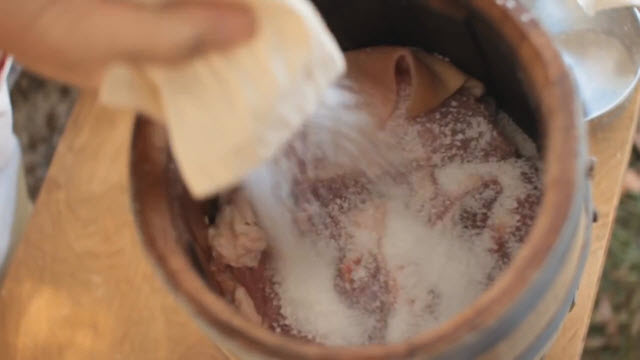 Make sure everything is spread out evenly.
Make sure everything is spread out evenly.
You can’t add too much salt, so don’t worry about getting too much salt in this. Better to have too much than too little.
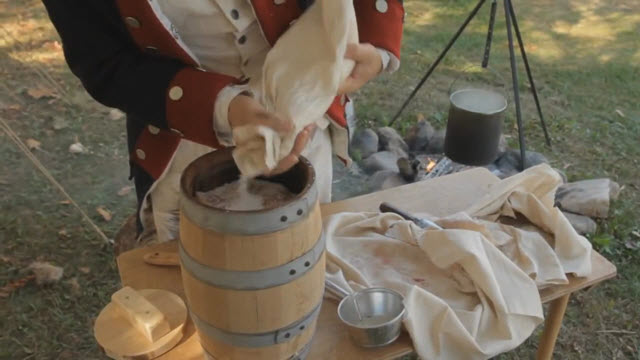
Fill the container until there is a small space near the top then pour in the brine solution until full. The brine will fill in all the air pockets that were missed while filling in the meat and salt. Place the lid on top and weight it down to make sure that the meat remains covered in the brine solution.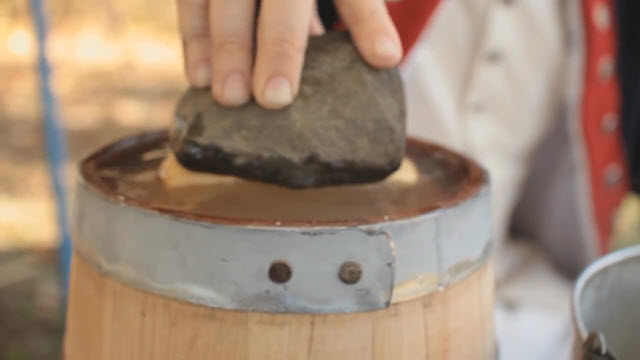 Place the container in a cool area. The cooler it remains, the longer the meat will remain edible.
Place the container in a cool area. The cooler it remains, the longer the meat will remain edible.
If at any time you see some frothing on top that means there is something going on. This needs to be taken care immediately. Pour the brine solution off, scald the brine solution and pour it back on again.
When it comes time to use your salt pork and you pull it out of the barrel, you need to soak it, sometimes overnight, but at least 2 hours. You want to soak it in fresh water, changing the water often so that you get as much salt out of the pork as possible. You’re never going to get it all. It’s going to be salty, but other than that, you use it like you would any fresh cut. You can use it in any recipe.
Transcription of Video:
As we talked about in earlier videos, pork was one of the most common and popular meats in the 18th century. It was one of the meats that would be supplied in rations for soldiers. It was a common thing for sailors and the entire population. Pork was salted so that it would last any number of months and could be transported, used in ships, the sailors could eat it later on. Today we’re going to show you a method for salting and preserving your pork in an 18th century manner.
Salting is an ancient technique, even previous to the Romans, very easily documented. There are a couple of different variations of salting. Sometimes they would just pack their meat in salt water or brine, sometimes they would hard pack it with lots of salt and then there’s even adding salt peter to it for a deeper preservation technique that might last a little bit longer, but didn’t taste as well. Today we’re going to prepare our salt pork in this 2 gallon oak keg. This one is a well bucket keg that we sell at Jas Townsend & Son’s. This doesn’t have the holes drilled in it. You can ask for a keg like that if you want to do a similar project. This one has been touched up on the inside. We took a torch and melted out the excess wax here at the top, and we also prepared a little wooden lid that will press down on the pork and keep it inside the brine solution.
Before we get started packing our meat, we need a hot brine solution prepared.
There’s a common misconception that salt pork is easy to come by these days. You’ll find something in a modern grocery store that’s called salt pork, but in reality it’s nothing like what was known as salt pork in the 18th century. This is just a cured but unsmoked pork belly product, but it isn’t actually prepared in a manner that 18th century salt pork was. So rather than use a pork belly, we’re going to use a pork shoulder or this is a picnic. I’ve got our pork already cut up into about 1 pound size pieces. We’ve got to have it so we can put it in in layers so the salt can get into it, so we’ve got 1 pound pieces here. We’re going to put about a cup of salt into our barrel here so that we’ve got a layer of salt in the very bottom. We’re going to spread that out and make sure it’s nice and even and now we’re going to start putting our pork into the barrel. We’ve got rind pieces on this. These rinds, you want to make sure, are toward the bottom or toward the outside edges with the meat parts on the inside. You want to pack this tight. You want to have as small a quantity of air pockets as possible. Each time we put in another layer of meat, we put in another layer of salt. Make sure that’s all spread out evenly.
Get this tightly packed, and we add more salt.
You can’t add too much salt, so don’t worry about getting too much salt in this. Better to have too much than too little.
That’s our final piece of meat. The keg is pretty much full. There’s still some space there at the top. The final step here is going to be pouring the hot brine solution in. That will fill in all the gaps and seal it up, and then I’m going to put our lid on.
So a method in the 18th century to see whether our brine solution was briny enough was to float an egg. This is just a regular raw egg, still in the shell, and we can see that this egg is floating in the solution, so we know its thick enough. There’s enough salt in here.
Here’s our hot brine solution. We know that it’s thick enough. We’re going to start pouring it in on top until it completely covers our meat, and then it’s time for your wooden lid. We’re going to float that up on top and then finally to make sure that this lid presses down on top of the meat we’re going to place a weight on top. If we see some frothing that means something is going on. We need to take care of that. We need to pour the brine solution off, you need to scald the brine solution and then you can put it back on again.
Well, our keg is ready to store now. In the 18th century it was traditional to process pork and beef products, when they salt it, they would do that in the fall when the temperatures were cool. It would make this last a lot longer. That’s the same thing we’re going to do. We’re going to take this keg and we’re going to put it in the refrigerator to keep it nice and cool so that it doesn’t go bad. It will probably last and be good for several weeks, put in a cool place like that. In the 18th century they would use it all through the winter into the next spring.
When it comes time to use your salt pork and you pull it out of the barrel, you need to soak it. You need to soak it sometimes overnight, but at least 2 hours. You want to soak it in fresh water, changing the water often so that you get as much salt out of that pork as possible. You’re never going to get it all. It’s going to be a salty thing, but other than that, you use it like you would any fresh cut. You can use it in any recipe.
Well, there you have it, salt pork. All the things you’ve seen in this video today, you can see on our website or in our print catalog and don’t forget to follow us on Facebook.


By fortuitous happenstance, I just read _Salt_ by Mark Kurlansky, which got me wanting to try old-fashioned recipes like this.